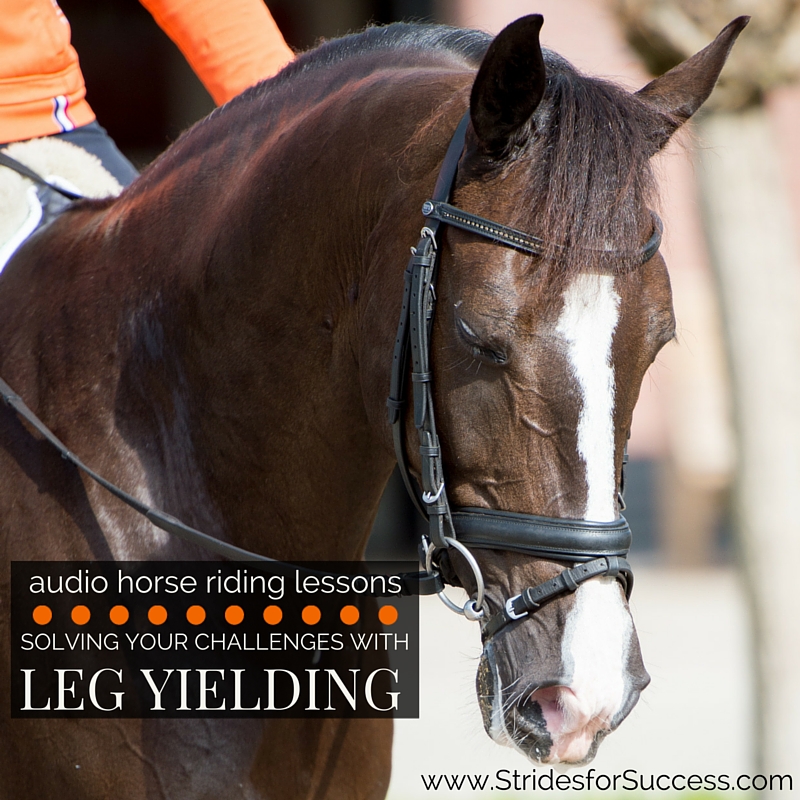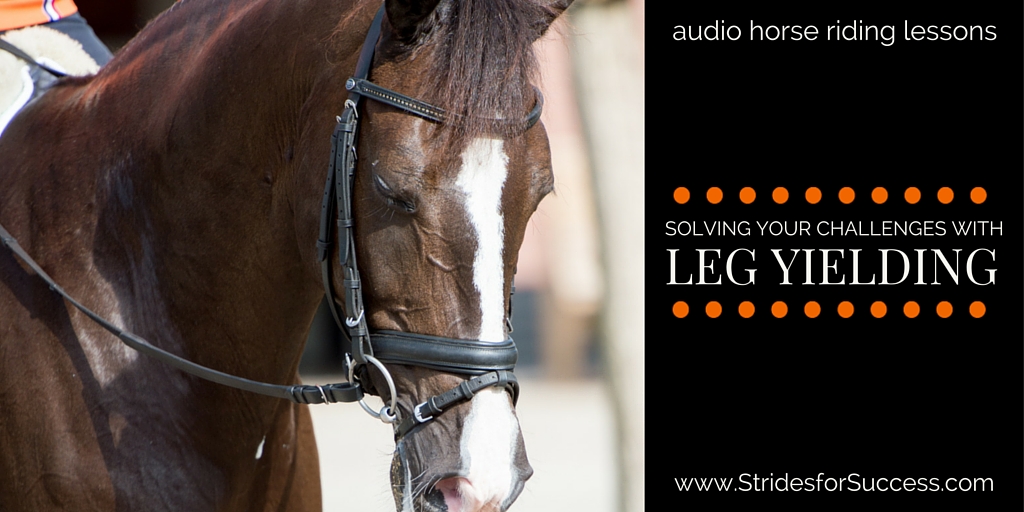How many times have you asked your horse to leg yield, moving forward yet sideways, only for it to become frustratingly obvious a few steps into the moment that what is happening underneath you is definitely not what you had in mind?!
Asking our horses to leg yield is one of the first introductions they will have to lateral movement. It introduces our horse to the concept of not just going in straight lines and moving forward, but also adding in some lateral or sideways movement as well.
It is a wonderful exercise for supplying our horses and has the added benefit of being easy enough to introduce to younger or less schooled and developed horses who have not yet achieved collection in their gaits.
What is Leg Yield?
A true and correct leg yield happens when your horse moves forward and sideways, along a diagonal line, keeping their back straight with a slight flexion of the poll away from the direction you are travelling.
So, if we were traveling down the center line and wanted to leg yield to the right, back to the track… Your horse will flex his poll to the left. Your left leg and hand will be your inside. While your right leg and hand will be your outside.
Leg yield is when your horse is moving forwards AND sideways. While maintaining rhythm, tempo, balance, and forward impulsion or energy in a consistent way throughout the movement. No change…

What Can Go Wrong?
While the leg yield is seen as a basic movement and, as mentioned, an introduction to more advanced and challenging lateral movements, there are many factors that can go wrong both before, during, and then after the movement.
-
-
-
- Your horse’s hindquarters may trail or lead the shoulders
- Too much bend through his neck or back
- Loss of rhythm and tempo
- Loss of forward movement or impulsion
- Lack of preparation by rider before the movement
- The rider leaning or ‘shoving’ the horse using shoulders or hips
- The rider’s reins being too long
-
-
Does Your Horse Understand?
Before we get into how to solve each of these problems, I think it is important to first make sure your horse understands what is being asked of him as he is performing the movement. You can do it on the ground. Simply ask for sideways movement.
For example, in the stable, while grooming, you will ask him to move ‘Over’. As you ask, apply pressure with your hand on the area that you will later apply similar pressure with your leg while riding.
You can also take your horse into the arena or schooling area and again, using pressure from your hand with the simple ‘Over’ command, ask him to move away from that pressure. This then translates well into the saddle, when you can again ask for ‘Over’ and apply the pressure with your leg where you have been training your horse to move away from with the same voice command using your hand.
I have a full program Groundwork for Riding that teaches you how to do this and more HERE
Improving the Quality of the Leg Yield
Once your horse begins to recognize and understand what ‘Over’ is and what you require of him to perform the movement, you can then begin focusing on the quality of the movement.
As mentioned, one of the big challenges is keeping your horse straight throughout the movement. Simply put, his shoulders must remain square in front of his hind quarters throughout the leg yield.
It will be your horse’s natural inclination to rather have his hindquarters trailing his shoulders, which will mean that he is either bending through his back or that he is falling out through his outside shoulder. Keep in mind that your horse must remain straight through his back at all times.
One of the easiest ways to keep focused on where you are going is to keep your horse’s shoulders square to something while keeping his back parallel to another marker. This way, you have a reference point of sorts by which to measure the quality of the forward and sideways movement.
I suggest beginning on the quarter line, shoulders square to the end of the arena, and then asking for a leg yield back to the track, all the while keeping his back parallel to the outside track while the shoulders remain square to the end.
Begin in Walk
Start your preparations in the walk, as like many riding movements, it is easier to perform the leg yield in the walk first and then work up to trot. Focus on establishing a rhythm that has your horse moving forward in the walk. Pay attention that you are moving with your horse, following the movement and that you are sitting correctly in the saddle, weight equally distributed across both seat bones.
As you ask your horse to yield to your leg, keep this phrase in mind… “Leg yield, not rein yield!”
Often we become so focused on our horse moving sideways that we forget it is primarily off the leg rather than the hand or rein. Remember to use your inside rein to merely ask for a slight bend through the poll, a small flexion to the inside (which will be in this case the side your horse is yielding to). For example, when leg yielding from the left to the right (a leg yield to the right), your left side will be your inside.
Engage Your Outside Rein
Also, remember that your outside rein is there to help regulate the rhythm. And also ‘gather up’ the movement created from your inside leg. Very often when riders are asking their horse to leg yield, they overuse the inside rein. This creates too much bend to the inside, while at the same time completely forget about the outside rein. This results in a loss of rhythm, perhaps even a break in the gait, and generally allows the energy to fall out through the outside shoulder.
Your outside rein will help hold the work you have put in during the preparation all together while your horse leg yields
Another important point to keep in mind is the reason you are asking your horse to leg yield, to begin with. It is not just a means to an end, but rather an exercise which when ridden correctly will improve your horse’s overall way of going. This means that while the quality of the leg yield itself is important, so too is how your horse finishes the movement and, even better, if it has improved his overall way of going afterward.
Your Outside Leg
Correct use of your outside leg will ensure you reach the end of the leg yield movement with the same impulsion and energy you had created and prepared while going into it. Very often riders are so focused on their horses yielding to their inside leg, that they completely forget about the outside leg. They only apply it to ‘end’ the leg yield and the sideways part of their horse’s direction.
Your outside leg is much more than this. It should be used to make sure your horse’s outside back leg remains engaged, pushing off and creating energy.
The inside back leg will cross over in front of the outside back leg each stride if the leg yield is being performed correctly.
However if the outside back leg is not then coming forward and underneath the horse with each stride, the horse will begin to move more exclusively sideways, rather than forward and sideways… Which is what’s necessary for a true leg yield
Rhythm; Step by Step…
Focus on riding the movement step by step. Rather ride two or three strides of correct leg yield than ten steps of mediocre or even bad quality. Make sure you are carrying your body, your hands and that your hips and pelvic area are relaxed and supple enough to allow both you and your horse to move.
Finally, make sure you are not leaning to one side or the other.
You should aim to remain perfectly upright, poised, and light in the saddle. Therefore allowing that improvement in your horses’ way of going that the leg yield will cultivate when prepared and ridden correctly.
Happy Riding
Lorna
Additional Resources on this Topic
-
-
- Leg Yielding to Refine Your Asking Aids in the Saddle
- Lateral Movement – Leg Yielding
- Using Lateral Work to Improve Your Walk
- FREE Weeks Riding Plan
- Online community for equestrians working on their mindset & fitness
- Online Community for equestrians focusing on re-schooling horses (and ex-racehorses)
-



1 Comment